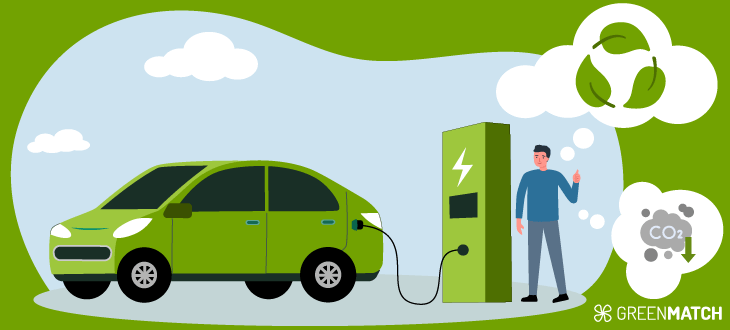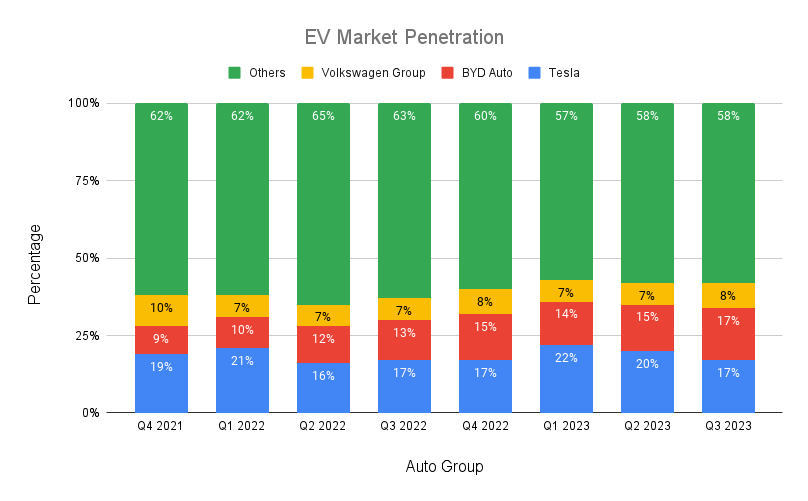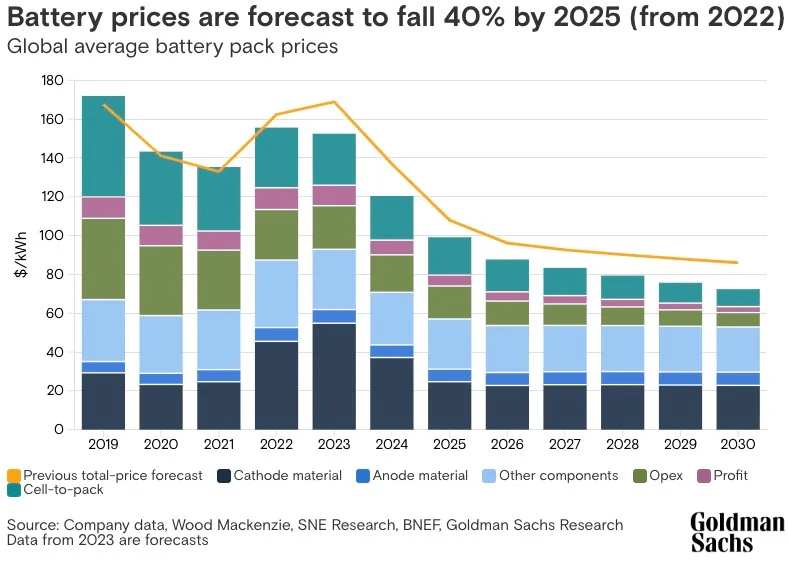- GreenMatch
- Electric Vehicles: A Deep Dive into the Statistics and Trends for 2025
Electric Vehicles: A Deep Dive into the Statistics and Trends for 2025

We're entering a new age of transportation, and the electric vehicle (EV) market is growing faster than ever before. In 2022, global EV sales topped 10 million, jumping up 55% from the year before.
EVs have become a game-changer. As we delve into this exciting new era of mobility, it's crucial to understand the statistics and trends shaping the industry. By 2024, it's forecasted that 25% of all new passenger car registrations will be electric, exceeding 17 million units in sales globally.

The global EV market, valued at £291.5 billion in 2023, is projected to more than double to £714.9 billion by 2030.
Technological advancements, environmental consciousness, and supportive government policies fuel this rapid growth. As we look ahead to 2024, understanding the statistics and trends shaping this industry is crucial.
We aim to provide you with a comprehensive understanding of the EV landscape, equipping you with the knowledge to navigate this rapidly evolving sector.
Global EV Market
The global electric vehicle (EV) market is experiencing a significant surge, with sales expected to reach 14.1 million units in 2023, a 34% growth compared to 2022.
This growth is projected to continue, with EVs forecasted to account for 23.5% of the global light-vehicle market by 2025 and 45.3% by 2030.
The top countries leading the EV market include Norway, where all-electric vehicles made up 80% of passenger vehicle sales in 2022, followed by Iceland (41%), Sweden (32%), the Netherlands (24%), and China (22%, equating to 4.4 million sales. Norway boasts the world's highest market penetration per capita, with EVs making up 86.2% of new car sales in 2021.
To provide a clearer picture of the global EV market, here is an intriguing overview from 2022 - 2030
| Region | 2022 EV Sales (Millions) | 2023 EV Sales (Millions) | 2024 EV Sales (Projected, Millions) | 2022 Market Share | 2023 Market Share | 2024 Market Share (Projected) |
|---|---|---|---|---|---|---|
| Global | 10 | 14 | 17 | 9% | 14% | 25% |
| North America | 1.3 | 1.8 | 2.2 | 7.3% | 9% | 11% |
| Europe | 3.5 | 4.9 | 6.8 | 35% | 40% | 45% |
| China | 4.4 | 6.2 | 7.5 | 33% | 38% | 42% |
Top EV Industry Statistics
- The electric vehicle (EV) industry is witnessing remarkable growth, with the global EV market valued at over £200 billion.
- As of 2023, more than 10 million EVs are on the road, with over 6 million plug-in EVs sold yearly.
- The industry's growth is projected to continue, with EVs expected to account for 46% of light-vehicle sales by 2025, growing to 68% by 2030 and 83% by 2035.
- In 2022, 14% of all new cars sold were electric, up from around 9% in 2021 and less than 5% in 2020.
- China, for instance, is the largest market for electric cars, with 40% of total sales projected by 2030.
- The United States broke records in 2022 with just under 918,500 light electric vehicle sales.
- The EV market is split among several manufacturers, with no single manufacturer holding a market share of over 15%
- Tesla has the largest market share (14.55%), followed by VW Group (12.52%).
- In 2021, Tesla sold almost 40% more than any other EV manufacturer.
- The following table presents the top-selling EV models on the road worldwide as of August 2023:
| Model | Country | Vehicles Sold (Jan-Aug 2023) |
|---|---|---|
| Tesla Model Y | US | 772,364 |
| Tesla Model 3 | US | 364,403 |
| BYD Atto 3 / Yuan Plus | China | 265,688 |
| BYD Dolphin | China | 222,825 |
| GAC Aion S | China | 160,69 |
Electric Vehicle Market Size
The market size is valued at £388.1 billion in 2023 and is projected to reach £951.9 billion by 2030, with a CAGR of 13.7%.
The top three players in the global EV industry in 2022 were BYD, Tesla, and Saic-GM-Wuling, with Tesla being the world's largest EV manufacturer.
In 2023, the market exceeded 10 million units, with a penetration rate of 14%, and it is expected to reach 14 million units with a penetration rate of 18% in 2024
Breakdown of Types of Electric Vehicles
The EV market is evolving rapidly, with models available in various vehicle types, from compact cars and sedans to sport utility vehicles (SUVs) and pickup trucks. According to Euromonitor's mobility forecasts, 25% of all new passenger car registrations will be electric in 2024, exceeding 17 million units in sales globally.
With EVs at the forefront, offering a greener alternative to traditional combustion engine vehicles. In the UK, the average cost of an electric car is around £50,000, ranging from £22,225 to a staggering £157,160.
Here's a quick breakdown of these four types:
| Type of EV | Description | Notable Statistics | Examples |
|---|---|---|---|
| BEVs | Run entirely on electricity with no gasoline engine. Rechargeable batteries power them and produce zero tailpipe emissions. | It accounted for over 70% of the total number of electric cars on the world's roads in 2022. | Audi e-tron, BMW i3, Chevrolet Bolt EV |
| PHEVs | Combine an internal combustion engine with an electric motor. They can be recharged from an external power source and operate on electric power alone for certain distances. | Sales are expected to grow significantly from 2023 to 2031. | Audi A8 Le-Tron, Ford Focus MHEV, and Honda Insight |
| HEV | Combine a conventional internal combustion engine with an electric motor. The batteries in HEVs cannot be recharged from an external source. | Widely available from various automakers | such as the Toyota Prius and Honda CR-Z, |
| FCEVs | Convert hydrogen gas into electricity and power an electric motor. They do not need to be recharged from an external source, as they are fueled with compressed hydrogen gas. | The global market for FCEVs is expected to exceed £135 billion by 2044, with a CAGR of 23% | Toyota Mirai and Hyundai Nexo. |
In 2023, global EV sales, including BEVs and PHEVs, are forecasted to reach 14.1 million units, marking a growth of 34% compared to 2022. The United States saw a 55% increase in electric car sales in 2022 relative to 2021, led by BEVs. In the same year, the share of electric cars in total sales tripled from around 4% in 2020 to 14%.
This growth is particularly notable in Europe, where BEVs and PHEVs accounted for 20.7% of new light-vehicle market sales in 2022.
The number of electric cars on the world's roads rose to 26 million in 2022, a 60% increase from 2021, with BEVs accounting for over 70% of this total annual growth.
What is the Proportion of electric cars sold to date
In 2022, 14% of all new vehicles sold globally were electric, a significant increase from around 9% in 2021 and less than 5% in 2020. This trend is expected to continue, with projections indicating that electric cars could account for 18% of total car sales across the entire calendar year of 2023.
In the United States, the market share of fully electric vehicles (BEVs) reached a new record of 7.9% in Q3 2023, up from 6.1% a year ago. Meanwhile, in China, the world's largest car market, the share of electric cars in total sales was 22% in 2022.

However, the adoption of electric vehicles varies significantly across different countries. For instance, in Norway, all-electric cars made up 80% of passenger vehicle sales in 2022, while in the United States, the figure was 6%
Here is a table summarising the Proportion of electric cars sold in different countries and regions:
| Country/Region | Proportion of Electric Cars Sold |
|---|---|
| Global | 14% |
| United States | 6% |
| China | 22% |
| Norway | 80% |
| European Union | 12% |
Upcoming Top Electric Vehicles
As we look ahead to 2024, several models stand out for their impressive specifications.
In 2024, the EV market will see the introduction of several exciting models. Tesla, a pioneer in the EV industry, is expected to launch the Cybertruck, a futuristic all-electric pickup truck. Rivian, a rising star in the EV market, is set to release the R1T, a luxury electric pickup with impressive off-road capabilities.
Here's a summary of the leading electric cars for 2024:
| Make and Model | Range (miles) | 0-60 mph (seconds) | Price (GBP) | Unique feature |
|---|---|---|---|---|
| Tesla Model 3 | 358 | 3.1 | £42,990 | offering semi-autonomous driving capabilities |
| Ford Mustang Mach-E | 379 | 3.7 | £41,330 | a hands-free tailgate and Ford's latest SYNC 4A infotainment system. |
| Volkswagen ID.4 | 323 | 7.4 | £37,800 | The ID.4 also features Volkswagen's innovative ID—light system, which uses an LED strip to communicate with the driver. |
| Nissan Ariya | 310 | 7.5 | £40,000 | The ProPILOT Assist 2.0 system provides semi-autonomous driving capabilities, and the e-Pedal allows for one-pedal driving. |
| Audi Q4 e-tron | 316 | 6.2 | £42,000 | The Q4 e-tron features Audi's signature design and advanced technology, including the Virtual Cockpit and a comprehensive suite of driver assistance systems |
| Rivian R1T | 314 | 3.0 | £61,300 | its "Gear Tunnel," a storage space that runs through the width of the vehicle, providing a unique and practical storage solution |
Top Electric Car Models for 2024
| Model | Manufacturer | Starting price (£) | Range (mi) | 0-60 mph (sec) | Towing Capacity (lbs) |
|---|---|---|---|---|---|
| Tesla Cybertruck | Tesla | 39,900 | 250+ | <6.5 | 7,500+ |
| Rivian R1T | Rivian | 67,500 | 300+ | 3 | 11,000 |
| Volkswagen ID.4 GTX | Volkswagen | 40,800 | 298 | 6.2 | N/A |
| Mercedes-Benz EQS | Mercedes-Benz | 99,995 | 478 | 4.1 | N/A |
Electric Vehicles Technology
Technological advancements are expected to drive the growth of the EV market. Research suggests that EVs could account for 40-60% of all new cars and SUVs sold by 2030. Moreover, solar panel EV charging stations can revolutionise the charging infrastructure. This can directly provide clean, renewable energy to electric vehicles, significantly reducing reliance on fossil fuel-generated electricity.
However, for solar electric cars, the number of solar panels required to charge an EV can vary widely. Typically ranging from 5 to 12 panels depending on the vehicle's battery capacity, daily mileage, panel wattage, and average sunlight exposure.
EV Battery Technology
The year 2024 promises to be pivotal for advancements in EV battery technology. These advancements in battery technology are expected to impact the EV industry profoundly.
For instance, General Motors is researching lithium-metal battery chemistry to increase range and lower the costs of electric cars.
Similarly, a China-based start-up, Gotion High-tech, plans to mass-produce its new lithium manganese iron phosphate (LMFP) battery by 2024, which promises a range of 1,000 kilometres.
Toyota is also developing new battery technology that will give future EVs a range of up to 932 miles (1,500km). From 2026, it will introduce new battery technology offering a range of 1,000km (621 miles) by increasing the battery's energy density, reducing weight, and improving vehicle aerodynamics.
This could lead to a significant increase in the adoption of EVs, with Goldman Sachs Research estimating that EVs could account for 21% of total global vehicle sales by 2025 and 47% by 2030.

In 2024, the focus will be on incorporating new chemistries in the EV battery, especially the cathode, which minimises the use of expensive metals such as lithium carbonate, nickel, and cobalt. This shift towards cheaper EV batteries is expected to significantly reduce the cost of EVs, making them more accessible to a broader range of consumers.
Battery pack prices are expected to fall by an average of 11% annually from 2023 to 2030. This price drop is anticipated to be particularly large in 2024. Goldman Sachs Research predicts battery prices will fall to £75 per kilowatt hour (kWh) of storage capacity by 2025 — a 40% decrease from 2022.
| Battery Technology | Energy Density | Charging Time | Life Span | Range | Commercialisation |
|---|---|---|---|---|---|
| Lithium-ion | High | Moderate | Long | 200+ mi | Current |
| Solid-state | Higher | Fast | Longer | TBD | 2024 (Expected) |
| Sulfur | TBD | Very Fast | TBD | 700 mi | 2024 (Expected) |
Some electric vehicles and their usable battery capacities:
Current State of EV Battery Technology
Most electric vehicles today use lithium-ion batteries, which offer high energy density, long cycle life, and a high power-to-weight ratio. These batteries have significantly improved the range of electric vehicles, with models like Tesla's Model S and Audi's e-tron SUV capable of travelling more than 200 miles on a single charge.
The Future of Electric Vehicle Battery Technology
The future of EV battery technology looks promising. With the anticipated advancements, we can expect EVs to become more affordable, efficient, and environmentally friendly.
60% reduction in CO2 emissions from battery production
Lithium manganese iron phosphate (LMFP) batteries with 1,000 km range
Sulfur batteries with tripled range and high-speed charging
| Year | Expected Battery Price (£/kWh) | Expected Battery Range (miles) |
|---|---|---|
| 2023 | 87.1 | 300 |
| 2024 | 95.4 | 500 |
| 2025 | 78.7 | 600 |
| 2026 | 64.2 | 621 (1,000km) |
| 2027 | 55.3 | 745 (1,200km) |
Charging Speeds and Infrastructure
Charging infrastructure is another critical aspect of EV technology.
Currently, Level 1 and Level 2 chargers can take anywhere from 40-50+ hours and 4-10 hours to charge a Battery Electric Vehicle (BEV) to 80% from empty.
On the other hand, Direct Current Fast Charging (DCFC) equipment can achieve the same in just 20 minutes to 1 hour.
The advent of fast charging technology, capable of charging an EV battery to 80% in as little as 30 minutes, is set to revolutionise the EV industry, making it more accessible to drivers and increasing the overall range of an EV.
Countries with the Highest Number of Publicly Available EVSE Chargers
China has the most significant number of publicly available EVSE chargers, with 1,810,000 chargers, followed by the Netherlands with 111,721 chargers, Germany with 87,674 chargers, and France with 83,317 chargers (IEA) and Statista.
| Rank | Country | Total Public Chargers | Fast Chargers | Slow Chargers |
|---|---|---|---|---|
| 1 | China | 1,810,000 | 760,000 | 1,050,000 |
| 2 | United States | 113,527 | 22,000 | 92,000 |
| 3 | Germany | 50,972 | 12,000 | 40,000 |
| 4 | Netherlands | 85,453 | 2,600 | 80,000 |
| 5 | France | 54,260 | 9,700 | 50,000 |
Vehicle-to-Grid Integration
Vehicle-to-grid (V2G) integration is a futuristic concept that turns your EV into a mobile energy storage. Not only can your EV store energy, but it can also feed energy back into the grid during peak demands.
Consumer Attitudes and Preferences
The shift from internal combustion engine (ICE) vehicles to EVs is not just about technology and infrastructure; it's also about people's perceptions, preferences, and purchasing decisions.
In 2023, a survey by the International Energy Agency (IEA) found that 60% of respondents would consider purchasing an EV as their next vehicle, up from 55% in 2022.
In 2023, the average price of a new EV in the UK was £40,000, compared to £30,000 for a new ICE vehicle.
Other important factors include the availability of charging infrastructure (46%), the driving range of the vehicle (49%), and the availability of government incentives (39%).
Despite this, the total cost of ownership, including fuel costs and maintenance, can be lower for EVs over the vehicle's lifetime.
| Factors | EVs | ICE Vehicles |
|---|---|---|
| Consumer Preference | 60% of respondents would consider purchasing an EV as their next vehicle. | 40% of respondents would consider buying an ICE vehicle as their next vehicle. |
| Average Price | The average price of a new EV in the UK was £40,000 in 2023. | The average price of a new ICE vehicle in the UK was £30,000 in 2023. |
| Total Cost of Ownership | It can be lower than ICE vehicles when fuel costs and maintenance are considered. | Typically higher than EVs when considering factors like fuel costs and maintenance. |
Comparison of EV and ICE Vehicle Prices
While the upfront cost of EVs is typically higher than ICE vehicles, the gap is narrowing. The average price of a new EV in the UK in 2023 is £40,000, compared to £30,000 for a new ICE vehicle. However, when considering the total cost of ownership, including fuel and maintenance costs, EVs can be cheaper than ICE vehicles over the vehicle's lifetime.
| Year | Average Price of New EV (£) | Average Price of New ICE Vehicle (£) |
|---|---|---|
| 2023 | 40,000 | 30,000 |
| 2024 | 38,000 | 31,000 |
| 2025 | 36,000 | 32,000 |
A recent study by Kantar surveyed 4,000 people across the US, UK, Germany, and Singapore, revealing critical insights into consumer attitudes towards EVs. Meanwhile, an analysis of Indian consumers identified charging infrastructure, government policy, and environmental awareness as significant factors influencing EV purchase decisions.
| Vehicle Type | Average Purchase Price (£) | Average Financing Cost (£) | Average Insurance Cost (£) | Average Fuel/Charging Cost for 15,000 miles per year (£) | Average Maintenance and Repair Cost over 5 years (£) | Average Depreciation over 5 years (£) |
|---|---|---|---|---|---|---|
| EV | 44,800 | 3,350 | 4,980 | 3,135 | 1,250 | 31,800 |
| ICE | 33,300 | 2,370 | 4,170 | 6,930 | 1,240 | 20,400 |
This table shows that EVs have a higher purchase price and financing cost but lower fuel/charging and maintenance costs. However, EVs also depreciated more over five years compared to ICE vehicles.
The Predicted Consumer Adoption of EVs
The International Energy Agency (IEA) predicts that the global share of electric car sales could reach 35% by 2030, with China maintaining its position as the largest market for electric cars, accounting for 40% of total sales by 2030.
In the United States, the adoption rate is projected to reach 7.06% in 2024, with mass adoption (16% of adult drivers) expected by 2028. California is leading the way in the US, reaching mass adoption in 2023.
In Europe, the share of EVs is expected to rise to 20% in 2024, with a forecasted market share of 40% by 2024, according to the European Automobile Manufacturers Association (ACEA). The EV market share in Europe is projected to reach 21.4% in 2023, climbing to 31.1% in 2025, then 68.6% in 2030, and 94.9% in 2035.
Challenges and Opportunities for EVs
The electric vehicle (EV) market faces several challenges but presents numerous opportunities for growth and expansion in 2024.
Current Challenges in the EV Market
- High Purchase Cost: The cost of EVs is a significant barrier to their adoption. The high price is primarily due to the expensive battery technology required for these vehicles.
- Range Anxiety refers to the fear that an EV will run out of power before reaching a charging station. The current lack of adequate charging infrastructure exacerbates this anxiety.
- Limited Selection: Although the variety of EV models is increasing, the selection is still limited compared to traditional vehicles.
- Grid Capacity: The existing electrical grid may not be able to handle the increased demand if EV adoption accelerates rapidly.
- Slowdown in Demand: Despite record sales, the growth of the EV market has slowed recently. High interest rates for car loans and concerns about resale value contribute to this slowdown.
Opportunities for Growth and Expansion in 2024
Solar electric cars, which integrate photovoltaic cells into their design, offer the potential to harness energy directly from the sun, paving the way for truly zero-emission transportation.
- Increasing Consumer Demand: Environmental concerns, improved battery capacity, cost savings, and a more comprehensive range of vehicle choices drive increased consumer demand for EVs.
- New Models: Dozens of new EV models are expected to debut by 2024, expanding consumer selection.
- Technological Advancements: Innovations in EV technology, such as increased miles per charge and vehicle-to-grid technology, are expected to continue in 2024.
- Government Policies: The Paris Agreement and other emissions targets could drive increased demand for EVs.
- Market Growth: The EV market is expected to grow rapidly, with some projections suggesting that EV sales could surpass 50% of total car sales by 2030.
- Decreasing Costs: EVs are expected to continue declining, potentially reaching a point in 2025 where the total cost of an EV is less than that of a combustion engine car.
In conclusion, while the EV market faces significant challenges, there are also numerous opportunities for growth and expansion in 2024.
The key to capitalising on these opportunities will be addressing the current challenges, particularly the high cost of EVs and range anxiety.

Inemesit is a seasoned content writer with 9 years of experience in B2B and B2C. Her expertise in sustainability and green technologies guides readers towards eco-friendly choices, significantly contributing to the field of renewable energy and environmental sustainability.
We strive to connect our customers with the right product and supplier. Would you like to be part of GreenMatch?

